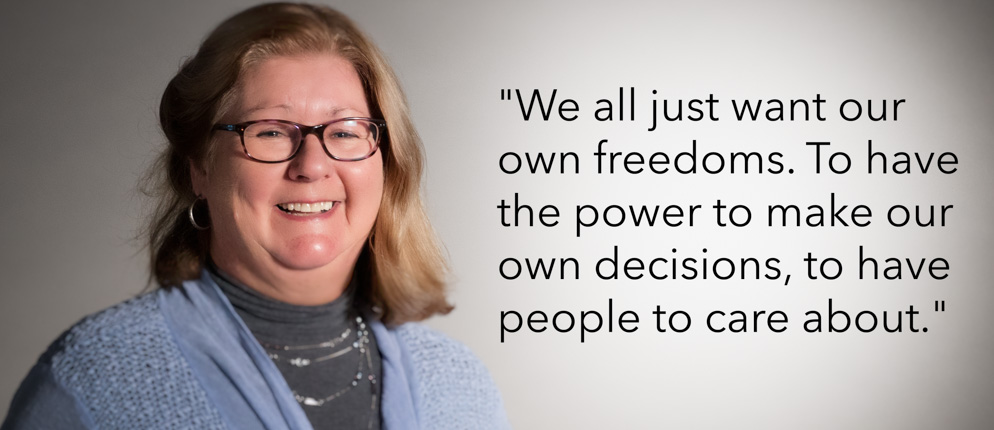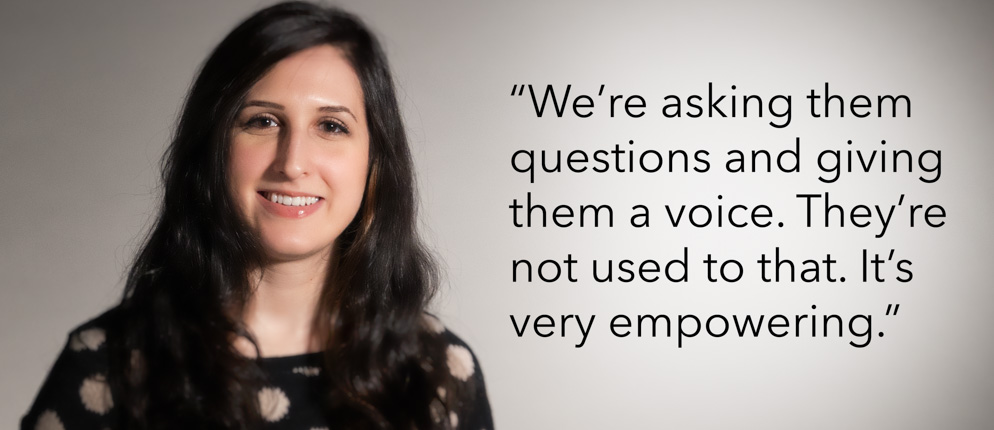What we can all learn from people with developmental delays about aging gracefully
UofGH researcher and student present at international conference for gerontologists
Steve had a life-changing experience one recent night while at karaoke. He got up there, confident, and sang. His staff, who care for him at the community residence where he now lives, was shocked. Dr. Brenda Elias, a researcher who’s interviewed Steve a number of times, adds: “When you’re non-verbal, and you’re 72, people don’t expect much of you.”
Steve is one of 65 people who now call a newly-built community residence in York Region home. But this home is unlike others. It has a different goal, a different vision, and according to Dr. Elias, a very different vibe.
It was built two years ago, in 2012, after 7 years of planning with Reena at the helm, a non-profit agency serving those with developmental delays, for which Dr. Elias is research director.
“It’s an innovative housing model – what we call an intentional community,” says Dr. Elias, who also teaches gerontology at the University of Guelph-Humber.
An intentional community
The intentional part lies in its unique, shared social vision. “The philosophy is social inclusiveness. Tenants will be asked to look out for their neighbours, and can expect the same from others living there. They’re expected to participate, to share. What we’re trying to accomplish here is a true sense of community.”
Those who live there have varying degrees and combinations of developmental, physical, cognitive and mental health needs – disabilities range from mobility to vision to hearing to anxiety to diabetes. Tenants also vary widely in age, falling between 18 to 82 years.
“We want for our tenants to get to know one another, to share, to engage -- because it will enrich their lives.”
And that’s the point.

Despite little research on the subject, people with developmental disabilities are living longer than expected: “They often experience symptoms of aging – but at a younger age. So this is surprising,” says Dr. Elias.
Research has shown longer life expectancies when accompanied by a strong supportive environment, such as multiple ages living together in a so-called ‘intentional community.’ Dr. Elias quickly points out the relevance with respect to the greater population.
“It’s the tender loving care that keeps these people going. And that’s what we’re trying to understand.”
How to measure successful aging
Dr. Elias’ current research project puts this social component at the forefront, and focuses on those living at the Reena residence: “A major focus examines whether people embrace this social vision that places importance on living and sharing life together, and whether these activities impact their perceptions of their own health.”
The study spans five years (2012–2017), so we’re about two years in. It uses both qualitative and quantitative ways of measuring what’s difficult to define - in essence, successful aging. Dr. Elias and her research team will interview each tenant at least 8 times over the course of the project, in order to assess psychological well-being, cognition and functional status.
Annelise Callisto is in her last year at UofGH, studying Family & Community Social Services. She’s been working as part of Dr. Elias’ research team, and recently joined her in presenting this project at the Gerontological Society of America’s Annual Scientific Meeting.
“What’s especially unique about this project is we’re getting the tenants themselves to tell us about their self-perceived health,” says Callisto, who’s been interviewing the tenants. “We’re looking at their overall satisfaction with the community residence, what they like about it, what they don’t like about it, what their daily life is like.”
She continues: “From what I’ve gathered so far, the feedback has generally been very positive. So far, they seem very happy. They’re enjoying the living conditions, and the building itself.”
An overwhelming majority can be described as “ecstatic”
It’s a four-storey complex, with one- two- and three-bedroom units, and round the clock supports for those who need it. Dr. Elias calls it beautiful and modern – there are wide hallways that fill with natural light from floor-to-ceiling windows. There’s a computer room, a garden, an education centre, meeting rooms, a greenhouse, a life-skills suite for special programs, a rec centre next door complete with two pools and a gym.
“They’re learning how to cook, how to clean their apartment, how to do laundry, how to be a good neighbour,” says Dr. Elias. “We’re fostering independence. We’re giving them a voice. We’re helping them to explore to the edges of their freedom. It’s huge, how much they’ve learned. Huge.”
Social participation levels to date, she adds, are beyond expectations.

Many have taken on volunteer activities in the surrounding community, some have found jobs at the nearby school, the nearby movie theatre, the Longo’s supermarket. “They’re contributing to their community, and they know it.”
Tenants also have a new level of control over their daily life. They give feedback to staff, they can decide what they need help with, and what they don’t need help with.
Callisto adds: “They’re making friends. Many of them never had a friend before. A few women made an appointment at a spa. They’ve asked for fire drills, they’ve elected a president for the tenant’s council. They’ve never been able to do that before. And they’re adults. It’s very empowering for them.”
“And the interaction,” adds Dr. Elias, “it’s frenzied. Go there at 3pm, when the programs are just ending, and there’s this high, intense energy. It’s amazing. It’s just a whole different environment, and it’s obvious when you walk down the halls. People look better, they’re less puffy and lethargic, they literally have a spring in their step.”
And in looking at the resulting impact on one’s self-perceived health, Dr. Elias has already seen indicators of success.
She reads a quote from one of her interviews: “I take care of my health now, like aquafit, yoga classes, feel as healthy as a horse. This is huge for them, to be able to monitor and assess their own health.” In future, Dr. Elias says they’ll be looking to see if there’s been a reduction in the number of hospital admissions, or in the number of ambulance calls.
“People need to be supported in order to care for their own health. Everybody in the population. But with this group – if they can do it, so can the rest of the population.”
“It’s been well-documented that social supports are vital to successful aging. We’re going to provide evidence to show that with changed self-perception of health, we can save money and improve people’s lives.”
She continues: “We’d love to duplicate this. We’re hoping to have enough data at the end of the five-year project to show the Ministry of Health that this will save health care dollars. There is a much more cost-effective model."
"But first, we need to show it works.”
Family & Community Social Services
Research at UofGH
More News


